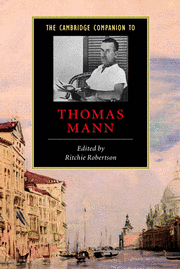Book contents
- Frontmatter
- 1 Mann and history
- 2 The intellectual world of Thomas Mann
- 3 Mann's literary techniques
- 4 Mann's man's world
- 5 Mann's early novellas
- 6 Classicism and its pitfalls
- 7 The political becomes personal
- 8 Buddenbrooks
- 9 The Magic Mountain
- 10 Religion and culture
- 11 Doctor Faustus
- 12 Lotte in Weimar
- 13 The Confessions of Felix Krull, Confidence Man
- 14 Mann as essayist
- 15 Mann as diarist
- 16 Mann in English
- Bibliography
- Index
6 - Classicism and its pitfalls
Death in Venice
Published online by Cambridge University Press: 28 May 2006
- Frontmatter
- 1 Mann and history
- 2 The intellectual world of Thomas Mann
- 3 Mann's literary techniques
- 4 Mann's man's world
- 5 Mann's early novellas
- 6 Classicism and its pitfalls
- 7 The political becomes personal
- 8 Buddenbrooks
- 9 The Magic Mountain
- 10 Religion and culture
- 11 Doctor Faustus
- 12 Lotte in Weimar
- 13 The Confessions of Felix Krull, Confidence Man
- 14 Mann as essayist
- 15 Mann as diarist
- 16 Mann in English
- Bibliography
- Index
Summary
While staying in Venice with his wife and brother between 26 May and 2 June 1911, Thomas Mann, like his fictional Aschenbach, was fascinated by a handsome Polish boy whom he watched playing on the beach. This 'personal and lyrical experience', as Mann later described it in a muchquoted confessional letter, prompted the story Death in Venice. And just as Mann's protagonist Aschenbach is inspired by the sight of Tadzio to write 'a page and a half of exquisite prose' on an unspecified problem of taste and culture (viii, 493), so Mann wrote a short essay on his changing attitude to Wagner. Having idolised Wagner for many years, he confessed, he was now turning away from the composer’s steamy Romanticism and towards a new classicism:
But if I consider the masterpiece of the twentieth century, I imagine something which differs from Wagner’s profoundly and, I think, for the better – something decidedly logical, formal and clear, something at once severe and serene, evincing no less will-power than Wagner’s, but intellectually cooler, more refined and even healthier, something that does not seek greatness in Baroque grandeur nor beauty in intoxication – a new classicism, I fancy, must come.
(x, 841–2)- Type
- Chapter
- Information
- The Cambridge Companion to Thomas Mann , pp. 95 - 106Publisher: Cambridge University PressPrint publication year: 2001
- 3
- Cited by



